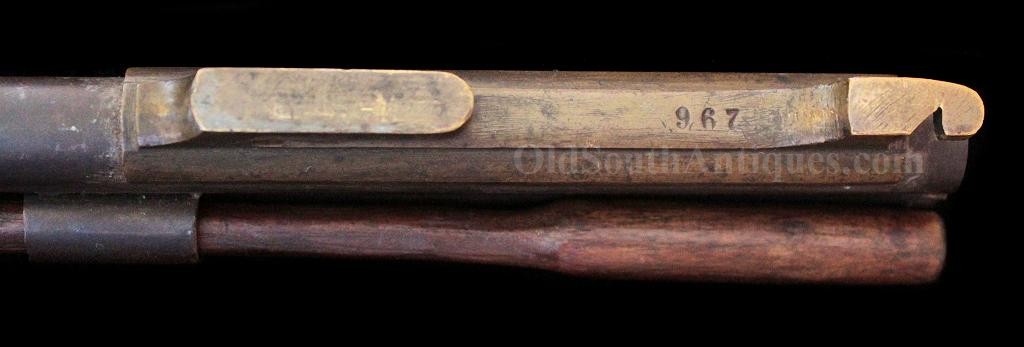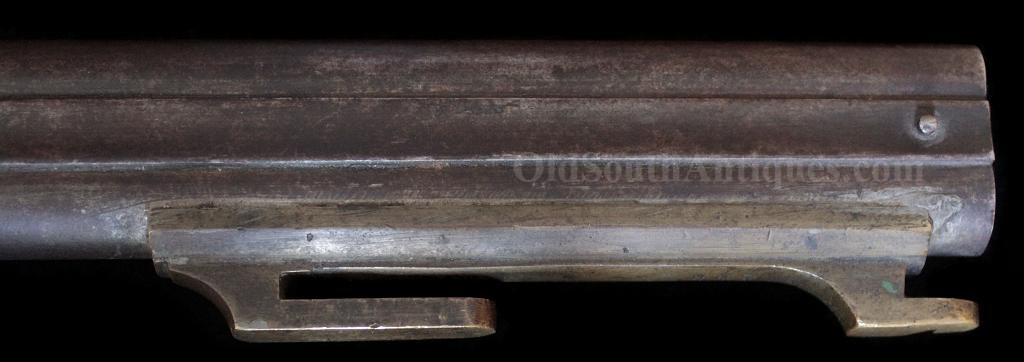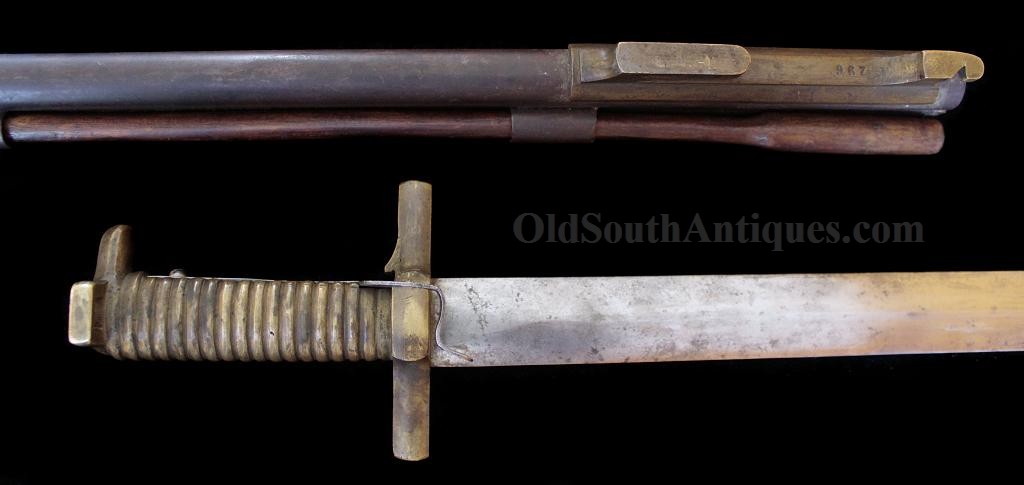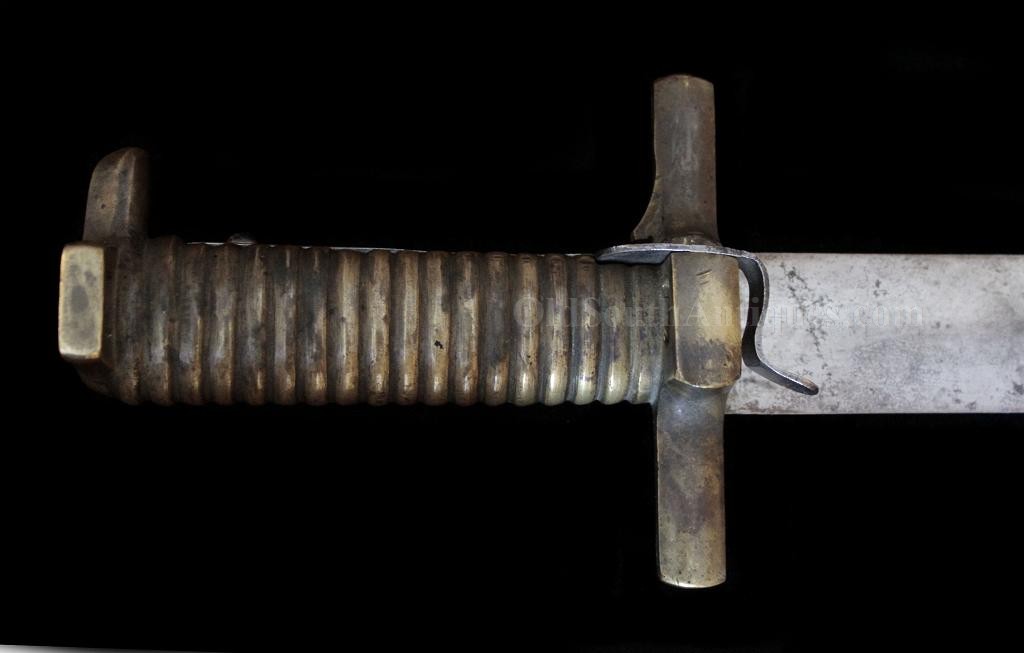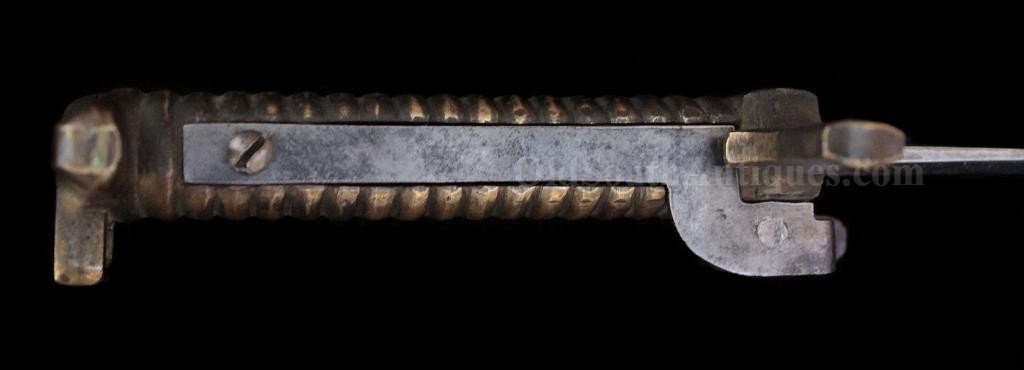
| Catalog | Past Items | Order Info | Terms/Conditions | About Us | Inventory Clearance |
This shotgun has been altered to an infantry arm by adding a brass bayonet lug, and attaching a saber bayonet, both of which were manufactured especially for these alterations. Military sling swivels and military nipples were also added to the shotgun’s original configuration. Until recently this work was believed to have been done at the Mobile, Alabama State Depot. Author and researcher Josh Phillips uncovered irrefutable evidence that this was incorrect. In fact, he discovered that these shotguns were turned into Confederate infantry arms by Cook and Brother of New Orleans, Louisiana. His research revealed much more, which Josh shared with us in North South Trader’s Civil War Magazine, Volume 37, Number 5, when these shotguns were the cover article.
These arms had been collected from Alabama’s citizens and consisted primarily of sporting rifles and shotguns. Once the bayonet had been added to this .16 gauge shotgun, it was as serviceable for infantry as any smoothbore musket in the Confederate Army; in fact, better, as the bearer had two shots.
Confederate Maj. Gen. Mansfield Lovell had a mighty task and he knew it. Charged with guarding the lower Mississippi and New Orleans, he had few trained troops and even fewer arms with which to do the job.
As he later described, "I will here state that every Confederate soldier in New Orleans… had been ordered to Corinth, to join General Beauregard in March, and the city was only garrisoned by about 3000 ninety day troops called out by the governor at my request, of whom about 1,200 had muskets and the remainder shotguns of an indifferent description.”
In late March 1862 the Federal fleet had entered the river, the situation was dire, and the government was gathering all available troops. One of the units answering the call was the local Chalmette Regiment, which took its name from the locality where the Battle of New Orleans had been fought in 1815.
A single company of the Chalmette Regiment was sent to reinforce Fort St. Philip, now inundated with 3-18 inches of water and the rest to guard the creeks and swamps. Other companies of the Chalmette Regiment were guarding the west bank of the river near the Quarantine Station above New Orleans, now isolated because of the flooding.
Admiral Farragut’s armada, after six days of fighting, attempted to run by the forts guarding the river in the pre-dawn darkness of April 24th. The Cayugaled the way at 3:00 A.M. Though having been hit 42 times, the Cayuga never slowed, its commander not seeing Farragut’s signal to regroup after passing the forts.
Advancing up the river the commander, Theodorus Bailey, "discovered a camp with rebel flag flying. Opened with canister. At 5 A.M. received the sword and flag of Colonel Szymanski and his command of five companies, arms and camp equipage.” These were the unfortunate Chalmette Companies who were totally surrounded by the high water and cut off from all escape and unable to defend against the gunboats. The canister mentioned in Bailey’s report killed and wounded 31 Confederates. Colonel Szymanski explained to a court of inquiry, "When the forts were passed just about the break of day the fleet came upon my small camp and opened fire, after losing some 30 men killed and wounded, without a possibility of escape or rescue —perfectly at the mercy of the enemy, he being able to cut the levee and drown me out—I thought it my duty to surrender. A single shell could have cut the light embankment.”
Baily ordered the Louisiana regiment to pile their shotguns on the river bank. The bayoneted shotguns were no doubt a curiosity to Federal officers, and several were taken as souvenirs, the rest were thrown into the river. This accounts for the extremely low survival rate of these weapons. These souvenir hunters cared nothing about matching bayonet numbers to the shotgun numbers, so none of the five existing specimens have their matching numbered bayonet intact.
As mentioned, these shotgun and bayonet combinations have for years been attributed to the Mobile Depot, but Josh Phillips’ research has shown that to be incorrect. The bayonets were manufactured and the shotguns were adapted to a Confederate infantry arm by Cook & Brother, the well-known Confederate gun makers of New Orleans. For each bayonet, scabbard and alteration Cook was paid $9.00. These shotguns had numbered lugs and a number on the bayonet. In addition, these guns have numbers stamped into the stock. The numbers on the lug and the bayonet are no doubt matching numbers, but the meaning of the numbers found stamped into the stocks is unclear.
Through all of Norm Flayderman’s many years he only encountered one of these rare guns; author Josh Phillips knew of three. The authors of Confederate & Southern Agent Marked Shotguns added two to Josh’s list, making this the fifth known survivor. Of these, only three have the original Cook & Brother shotgun bayonet attached, and only two with the original scabbards; but both scabbards are identical, leaving no doubt that these are the correct scabbards.
This example has a brass lug with the number 967 stamped into it, and the special bayonet, numbered 157; the stock’s left face bears numbers 46 over 22, and its right face the numbers 3 over 863. The shotgun’s condition is flawless; the metal is perfect and has a beautiful original patina. It is one hundred percent original and retains its original military sling swivels (no doubt added as part of the Cook & Brother alteration process) and even its original ramrod. The bayonet is beautiful and flawless as well and is still sheathed in its original scabbard. The brass on the scabbard has been partially cleaned, but it has to be the original, as it would have been impossible to find the correct Cook & Brother scabbard loose, nor prior to the discovery that it was identical to the other example could neither have been determined to be original. The scabbard’s leather is in excellent and strong condition.
The shotgun’s mechanics work perfectly, both of the bores are in very good condition. Those wet and muddy forlorn men who tossed them down in disgust on the riverbank 157 years ago would scarcely believe that they are remembered today because of the unique weapons they carried. All honour to them for their suffering and sacrifice.
This Infantry
Shotgun is published and described on pages 43, 46 and 47 of Confederate & Southern Agent Marked
Shotguns. It is without a doubt one
of the rarest Confederate infantry arms on the planet and has a wonderfully
detailed history.
Copyright © 2024 OldSouthAntiques.com All Rights Reserved.
Privacy Policy | Terms of Use
Powered by Web-Cat Copyright © 1996-2024 GrayCat Systems

